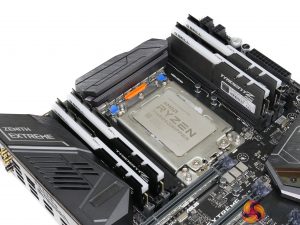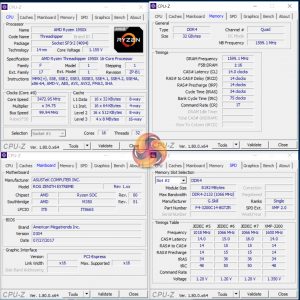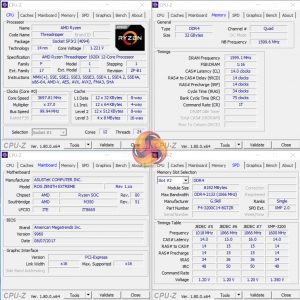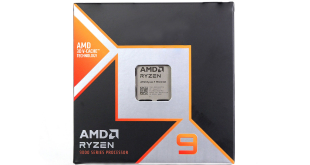We will be outlining the Ryzen Threadripper CPUs' performance while using an ASUS ROG Zenith Extreme X399 Socket TR4 motherboard. A 32GB (4x8GB) kit of G.Skill's 3200MHz CL14 DDR4 memory serves our test system.
Today's comparison processors come in the form of:
- Skylake-X i9-7900X (10C20T).
- Broadwell-E i7-6800K (6C12T) and i7-6950X (10C20T).
- Kaby Lake (and Kaby Lake-X) i7-7700K (4C8T) and i7-7740X (4C8T).
- Ryzen 7's 1700 (8C16T) and 1800X (8C16T).
- Ryzen 5's 1600X (6C12T).
Each processor is tested at its default out-of-the-box settings and when overclocked to a reasonable level. For the Intel CPUs, we ensured that forced-turbo was disabled so that Intel's defined Turbo Boost parameters were functioning correctly. As such, all-core load frequencies for the tested chips are as follows:
- Ryzen Threadripper 1950X = 3.7GHz.
- Ryzen Threadripper 1920X = 3.7GHz.
- Core i9-7900X = 4.0GHz (most of the time, with Handbrake or synthetic stress tests as an exception).
- Core i7-6950X = 3.4GHz (most of the time, with Handbrake or synthetic stress tests as an exception).
- Ryzen 7 1800X = 3.7GHz.
- Ryzen 7 1700 = 3.2GHz.
- Core i7-6800K = 3.5GHz.
- Core i7-7740X = 4.5GHz.
- Core i7-7700K = 4.4GHz.
- Ryzen 5 1600X = 3.7GHz.
CPU Test System Common Components:
- Graphics Card: Nvidia GeForce GTX 1080 Ti Founders Edition (custom fan curve to eliminate thermal throttling).
- CPU Cooler: Corsair H110i GT & Thermaltake Floe Riing 360 for AMD Threadripper Socket TR4 CPUs.
- Games SSD: SK hynix SE3010 SATA 6Gbps 960GB.
- Power Supply: Seasonic Platinum 760W.
- Operating System: Windows 10 Pro 64-bit (Creators Edition).
Ryzen Threadripper X399 System (Ryzen TR 1950X, Ryzen TR 1920X):
- Ryzen TR 1950X CPU: AMD Ryzen Threadripper 1950X ‘Threadripper' 16 cores, 32 threads (3.95GHz @ 1.3875V overclocked).
- Ryzen TR 1920X CPU: AMD Ryzen Threadripper 1920X ‘Threadripper' 12 cores, 24 threads (4.0GHz @ 1.3875V overclocked).
- Motherboard: ASUS ROG Zenith Extreme (TR4, X399).
- Memory: 32GB (4x8GB) G.Skill Trident Z 3200MHz 14-14-14-34 DDR4 @ 1.35V.
- System Drive: Crucial MX300 525GB.
Skylake-X LGA 2066 System (i7-7740X, i9-7900X):
- 7740X CPU: Intel Core i7 7740X ‘Kaby Lake-X' (ES) 4 cores, 8 threads (5.1GHz @ 1.30V overclocked).
- 7900X CPU: Intel Core i9 7900X ‘Skylake-X' (ES) 10 cores, 20 threads (4.6GHz @ 1.20V overclocked).
- Motherboard: ASUS X299-Deluxe (LGA 2066, X299).
- Memory: 16GB (2x8GB) or 32GB (4x8GB) G.Skill Trident Z 3200MHz 14-14-14-34 DDR4 @ 1.35V.
- System Drive: Samsung 840 500GB.
Ryzen AM4 System (Ryzen 5 1600X, Ryzen 7 1700, Ryzen 7 1800X):
- 1800X CPU: AMD Ryzen 7 1800X ‘Summit Ridge' 8 cores, 16 threads (4.05GHz @ 1.425V overclocked).
- 1700 CPU: AMD Ryzen 7 1700 ‘Summit Ridge' 8 cores, 16 threads.
- 1600X CPU: AMD Ryzen 5 1600X ‘Summit Ridge' 6 cores, 12 threads (4.0GHz @ 1.4125V overclocked).
- Motherboard: Gigabyte Aorus AX370-Gaming 5 & ASUS Crosshair VI Hero (AM4, X370, AGESA 1006).
- Memory: 16GB (2x8GB) G.Skill FlareX 3200MHz 14-14-14-34 DDR4 @ 1.35V.
- System Drive: SanDisk Ultra Plus 256GB.
Kaby Lake LGA 1151 System (i7-7700K):
- 7700K CPU: Intel Core i7-7700K ‘Kaby Lake' (Retail) 4 cores, 8 threads (4.8GHz @ 1.35V overclocked).
- Motherboard: ASUS Maximus VIII Hero (LGA 1151, Z170).
- Memory: 16GB (2x8GB) G.Skill FlareX 3200MHz 14-14-14-34 DDR4 @ 1.35V.
- System Drive: Micron M600 256GB.
Broadwell-E LGA 2011-3 System (i7-6800K, i7-6950X):
- 6800K CPU: Intel Core i7 6800K ‘Broadwell-E' (Retail) 6 cores, 12 threads (4.2GHz @ 1.275V overclocked).
- 6950X CPU: Intel Core i7 6950X ‘Broadwell-E' (Retail) 10 cores, 20 threads (4.2GHz @ 1.275V overclocked).
- Motherboard: ASUS ROG Strix X99 Gaming (LGA 2011-v3, X99).
- Memory: 32GB (4x8GB) G.Skill Trident Z 3200MHz 14-14-14-34 DDR4 @ 1.35V (at 3000MHz for the 6800K due to IMC weakness).
- System Drive: Kingston HyperX 3K 120GB.
Software:
- ASUS ROG Zenith Extreme BIOS v9960 (pre-release).
- GeForce 382.33 VGA drivers.
Tests:
Productivity-related:
- Cinebench R15 – All-core & single-core CPU benchmark (CPU)
- HandBrake – Convert 6.27GB 4K video recording using the Normal Profile setting and MP4 container (CPU)
- Mozilla Kraken – Browser-based JavaScript benchmark (CPU)
- x265 Benchmark – 1080p H.265/HEVC encoding benchmark (CPU)
- 7-Zip – Built-in 7-Zip benchmark test (CPU & Memory)
- SiSoft Sandra – Memory bandwidth (Memory)
Gaming-related:
- 3DMark Time Spy – Time Spy (DX12) test (Gaming)
- Ashes of the Singularity Escalation – Built-in benchmark tool CPU-Focused test, 1920 x 1080, Extreme quality preset, DX12 version (Gaming)
- Ghost Recon: Wildlands – Built-in benchmark tool, 1920 x 1080, Very High quality preset, DX12 (Gaming)
- Grand Theft Auto V – Built-in benchmark tool, 1920 x 1080, Maximum quality settings, Maximum Advanced Graphics, DX11 (Gaming)
- Metro: Last Light Redux – Built-in benchmark tool, 1920 x 1080, Very High quality settings, SSAA Enabled, AF 16X, High Tessellation, DX11 (Gaming)
- Total War Warhammer – Built-in benchmark tool, 1920 x 1080, Ultra quality preset, DX12 version (Gaming)
 KitGuru KitGuru.net – Tech News | Hardware News | Hardware Reviews | IOS | Mobile | Gaming | Graphics Cards
KitGuru KitGuru.net – Tech News | Hardware News | Hardware Reviews | IOS | Mobile | Gaming | Graphics Cards






So it’s a beast for productivity [if it’s capable of delivering reliability in the long run], and it’s just fine for gaming, but not as cool as Intel. Not bad, not that great either. No reason to go away from X299 for now. I wonder how will the 12 – 18core Intel fare, both with performance and prices. Great review, proving my point in many discussions, thank You 🙂
so single core comparation is done with intel set at 4.5-5GHz and AMDs at 4.0GHz, and you’re surprised of that Intel’s is better 😐
So to test the maximum overclocked speeds of each you want Luke to achieve a 4.5ghz overclock on the Ryzen even though its just not possible. Perhaps Gandalf can help him with some magical powers.
Yes. All testing is done at stock and the realistic achievable overclocks on each CPU. Throttling Intel back to X GHz would be unfair if the Intel chips can OC further. Just as it would be unfair to throttle back Ryzen CPUs if they have faster clock speeds than their competitors.
Stock and realistic OC frequency is what we always test on all CPUs. Intel’s Skylake-X and Kaby Lake CPUs tend to OC higher than AMD’s Ryzen chips so that’s what people run their frequencies at and that’s what we test with.
Luke
Ok, i get that but …
1. Same cooling was used for both?
2. Is TR restricted, or why can’t it go pass the boosted clocks?
So, considering that AMD again gives 50 and 60 percent more cores for a same or the similar price those CPUs are a beasts for people who need productivity and content creation CPU
Who games at 1080p with a £1000 CPU and a GTX1080 ti? Wasn’t Ryzen equal to its intel equivalent at higher resolutions, Is this the same with ThreadRipper?
“Cons” in the review are so depraved you can not even imagine, and lacking 1 star out of 10…. For what? For not being available for free?
Oxymorons
I have to slightly disagree with the gaming analysis. Many times the reason RYZEN doesn’t perform well in gaming is that game developers still haven’t had enough time to optimize the RYZEN platform. Game developers haven’t had enough time with the AMD RYZEN hardware development kits as of yet.
The same cooling was used for all CPUs (280mm AIO) except Threadripper which used a 360mm Asetek AIO due to mounting compatibility.
The frequency limits for Ryzen look to be related to the manufacturing process technology used by AMD. At its own fabs, Intel looks to have the ability to manufacture dies that can operate at a higher frequency in general.
1080P and a fast GPU helps isolate CPU performance by ensuring no resolution- or GPU-induced bottlenecks are introduced. Our 4K testing shows Ryzen to be far more competitive against Intel when the performance onus is planted more firmly on the GPU.
Ok, thank you. Maybe Threadripper will be able to get higher OCs with some bios updates, how it happened to Ryzen 🙂
Are you confident its not a fabric/zeppelin die limitation rather than the zen core or the ccx?
If that hasnt been eliminated, perhaps raven ridge can shed some light eventually? As i understand it, and given it must be low power for mobile, it will be a single 4 core zen ccx & a single vega gpu on a die like ryzens zeppelin die. Point being, maybe it can clock better in that die form.
Agreed. Irrespective of the amount cooling available, no multi cores CPU would survive a Prime95 stress test on all cores for 30 minutes, let alone 1 hour or more. Prime95 should be taken off the web.
Current rumors predict $1,700 for the 16-core, and $2,000 for the 18-core.
Hey Luke. May I ask how you obtained the all-core turbo frequencies of the 1920X and 1950X? And how confident are you that they are correct? I ask, only because other sources have consistently stated 3.60 GHz for the 1950X. Thank you very much for this in-depth review.
Those are not rumors, they are official Intel pricing, confirmed by multiple outlets and reviewers.
18 core Intel i9 will be $1999.99 (USD)
16 Core Intel i9 will be $1799.99 (USD)
Price v Performance is going AMD’s route, they will end up taking a good portion of the HEDT market with their aggressive pricing and their performance.
“But muh i9 is faster”..
It also has less PCI-E lanes, uses more energy, when overlocked Intel’s 10 core gets hotter than the 16 core AMD, and dollar per dollar is less of a value. This again has been confirmed in testing via many respected hardware outlets/reviewers.
I only have 12 years as an IT professional in hardware management systems, what would I know.
They got the 16 core 1950X to 5.2Ghz on LN2 (Liquid Nitrogen), while that was obviously not representative of real world operations, it did show what can be done.
The issue Intel faces is the technology change that is currently happening where we are switching software from single core/thread ops to multicore and having code recognize the maximum amount of cores possible.
How is this a problem for Intel?
Despite having an immense about of capital to work with an state-of-the-art R&D facilities, Intel’s latest chips have issues with overclocking all cores and remaining efficient. In fact if you look at Intel’s turbo boosts they downclock heavily after 4 cores to keep TDP and energy consumption manageable and competitive. Intel’s biggest weakness is their ability to maximize silicon yields, this is one of the reasons they charge so much for their CPU’s, while AMD’s current approach allows them to scale as they need to with less transistors required on a single die, maximizing yield.
At this current rate I fully expect AMD to release their Zen 2 7nm CPU before Intel gets Cannon Lake (10nm) CPU’s out as AMD is already reporting over 80% yields with 14nm silicon, and anything above 60% yield allows for very competitive prices.
Okay, thanks John. And for the record, yes, I am fully supportive of Threadripper. Intel has been screwing people over for too long.
I’m not sure why you decided to say this, however.
Intel chips are NOT cool. Not even the 91w i5’s. Unless if you think 80c on watercooling for a STOCK i5 Skylake is cool.
Threadripper better as $1k for 16 cores 32 threads when intel like $2k for that. Ya had enough of limitations and greed
Why was enermax aio not used?
I agree. The 16-core 1950X was available on Amazon for $800 not too long ago.
Not as “cool”?, in what sense exactly? as in an over priced haircut kinda cool?
ur obviously a fanboy dick swinger, the only diff. this time u aint playing with the biggest dick.
All reviews out there on the net show Threadripper is faster in basically all productivity apps other than some outdated software that runs better on quads, TR uses less power, has better SMT, has more IO, costs less and has excellent motherboard support.
Wake up from ur delusional dream Bub, just ’cause ur sore that u overpaid for an overvolted stove top cpu that don’t do shit, don’t mean u have to spread ur bull shit propaganda.
Love the 1950x. Runs well at 4.1GHz, and running Prime95 simultaneously w/CPU-Z stress (all cores at 100%), T 105 fps. Other benchmarks show very good performance and durability.